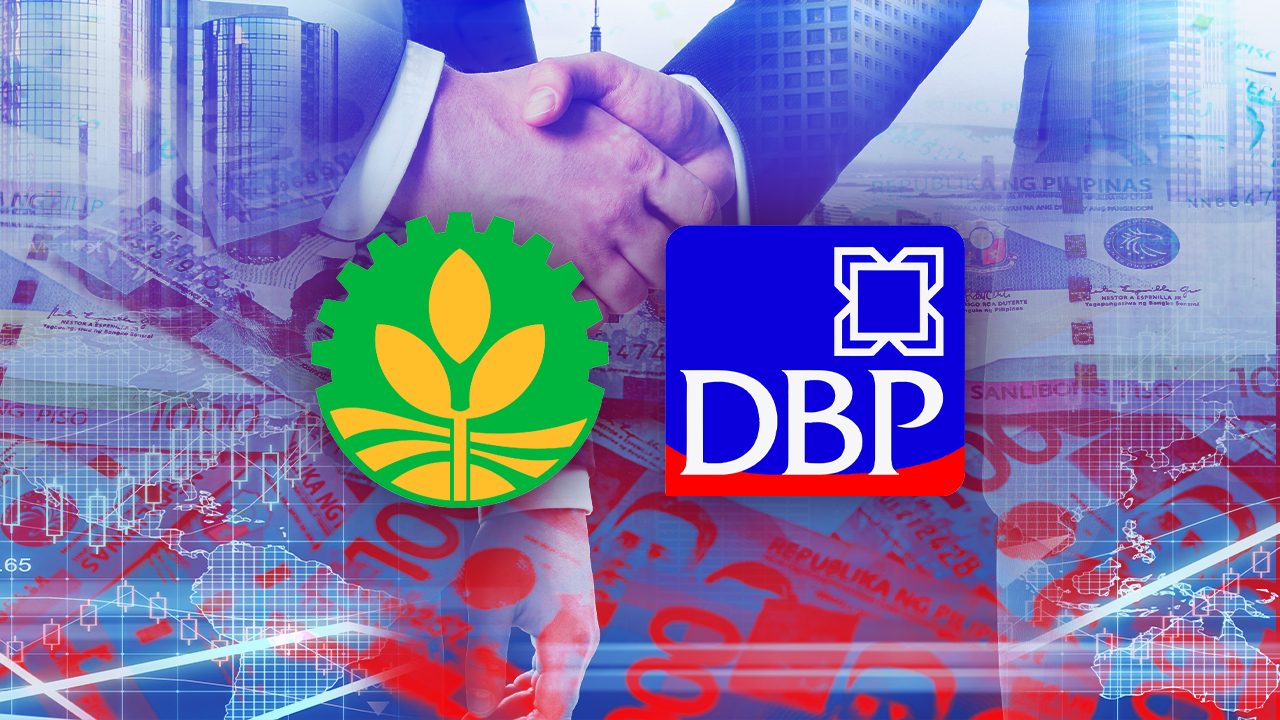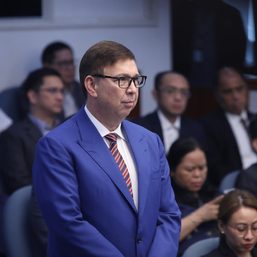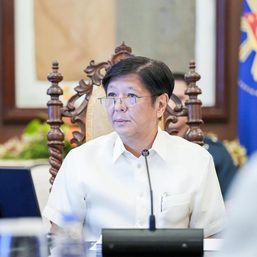SUMMARY
This is AI generated summarization, which may have errors. For context, always refer to the full article.

MANILA, Philippines – The Land Bank of the Philippines (Landbank) and Development Bank of the Philippines (DBP) could be merged into one “superbank” as early as November of this year.
The Department of Finance (DOF) has insisted that a unified state bank would make a “bigger and stronger bank to better serve the country’s development needs.” The DBP, on the other hand, has been strongly opposed to the merger – its very existence under threat, with Landbank designated as the surviving entity.
But remember: this proposal is not new. The previous attempt to merge the two banks was already approved by the late president Benigno Aquino III, but the Duterte administration scrapped the plan mere months later. This latest push, however, now has the support of President Ferdinand Marcos Jr., according to Finance Secretary Benjamin Diokno.
So, what are the reasons behind the resurrected proposal?
Why merge the banks?
The DOF, under Diokno, is perhaps the biggest supporter of the move.
“The union of the two banks will make it the largest bank in the Philippines. A bigger and stronger government bank will best serve the country’s development objectives. Its consolidated resources will also allow it to withstand shocks arising from financial and economic stress,” said the finance secretary during a media dialogue on May 5.
To some, Diokno’s support comes as a surprise, given that he was among the Cabinet members under Duterte who had canceled the previous merger attempt. But he now lists several reasons why consolidating the two state banks would be beneficial:
- Wider branch network
- Increased efficiency
- More funds to loan out
- One state bank for government transactions
Let’s go through all of these.
The most immediately visible change under the merger would be the consolidation of the two bank’s branch networks. With Landbank being the surviving entity of the merger, DBP branches will be absorbed and converted into Landbank branches.
The merged state bank would end up with 627 branches nationwide, with an ambitious plan to set up at least one Landbank touchpoint – either a branch, ATM, agent banking partner, cash deposit machine, or point of sale – in every municipality by August 2024.
Though each bank has its own separate charter – with Landbank envisioned to cater mostly to the agricultural sector and the DBP to industries – the DOF said that they share the mandate of providing “banking services for agricultural and industrial enterprise and to spur countryside development.”
“Upon their merger, there will be two lending windows catering to the distinct mandates of the combining entities: one window to address the needs of the enterprises in the agricultural value chain and a second window for infrastructure and non-agricultural clients,” the DOF said in an attempt to allay DBP’s fears that the merger would dilute the focus of the banks on their respective target market.
Combining the two, according to the DOF, will tidy up redundancies and inefficiencies in operations. They can save costs by sharing a single information-technology system and treasury team, and having leaner back and middle offices.
The merger is projected to save at least P5.3 billion a year in operating costs by virtue of economies of scale. The DOF added that the multi-billion peso figure is a conservative estimate that doesn’t include gains from the sale of the DBP’s head office, its property in Bonifacio Global City, branches, and licenses.
A consolidated state bank could also widen the headroom for development project loans, given the money the bank could save. The DOF estimates that an additional P80.3 billion in loans per year could be given out, which could pave the way for some of the government’s priority projects.
Diokno also highlighted that having a single government bank can simplify transactions with government-affiliated organizations, other banks, and development partners like the World Bank, Asian Development Bank, and Japan International Cooperation Agency.
“The merged bank will be in the best position to serve as the sole authorized government depository bank for all National Government agencies, Government Owned or Controlled Corporations, government instrumentalities, and local government units,” he said. “A key strategic benefit of having a single government bank is that it simplifies transactions with counterparty banks, multilateral development banks, and regional development banks.”
All in all, the effect of the merger would be to create the largest bank in the Philippines by asset size and deposit size, surpassing BDO Unibank in both categories. It would have more than P4.1 trillion in assets and P3.5 trillion in deposit base.
‘Too big to fail, too big to save’
But bigger is not always better – at least, according to the DBP.
“The complete expression is ‘too big to fail, too big to save.’ That’s a fundamental principle in public finance,” said DBP Chairman Dante Tinga in a press conference on Tuesday, May 9.
In a position paper opposing the merger, the DBP also noted that combining the two banks to form the largest in the country could concentrate risks and increase its vulnerability to “financial market bubbles and cyberattacks.”
Tinga also cited the recent collapse of Credit Suisse as an example of why size may not always imply stability. It was the second largest bank in Switzerland before its collapse, forcing the Swiss government to intervene and ask the country’s largest bank – UBS – to buy it out and “protect the economy” from the potential fallout.
“If that happens in the Philippines – the superbank, the monolithic bank that comes out of the merger, it collapses – what happens to the economy? As it is, maganda na ‘yung dalawang bangko magpatuloy (it’s already good to continue with two banks). They just need to be retooled,” Tinga said.
Diokno, on the contrary, viewed the collapse of Credit Suisse as further proof that government banks should be consolidated.
“Given what’s happening now globally – you have banks which are now being closed. For example, Credit Suisse. Who would have thought that Credit Suisse would go under? There is really a strong need for solidifying the government bank,” Diokno said back in March when he confirmed plans to merge the state banks.
But this wasn’t the only area where Diokno and Tinga disagreed. The DBP chairman also disputed Diokno’s claims that the move would widen the network of the state bank, instead saying that the combined branches would result in a network of the same size and reach.
He also went further, warning about the danger of “putting all the eggs in one basket.”
“While the merged bank may become the largest bank in the country in terms of assets and deposit size, it will still suffer from capital shortage, bad loans, and lazy banking,” the DBP said in its position paper.
“Without a plan of integration, there is only consolidation of assets and LBP as the surviving entity will just have the same strengths and weaknesses pre-merger; the two banks will be truly complementary of each other’s strengths and weaknesses if they are to remain separate and independent,” it said.
How does this impact the banking industry?
The DBP also cautioned that the proposed superbank could violate the Philippine Competition Act and National Competition Policy. It warned that the merger “poses a grave threat to private capital” since the consolidated bank could participate in commercial banking activities while enjoying the advantage of a strong stream of funds, given that it would be set to receive all deposits from the government as the state’s official depository bank.
Meanwhile, BDO president and chief executive officer Nestor Tan does not expect the impending merger to greatly affect the private banking sector, even if Landbank would surpass them to become the biggest bank.
“I think Landbank and DBP merger won’t have much impact on privately-owned institutions because we compete in different markets. Of course, we do overlap in some areas, but it’s not an overlap in most markets,” he said during a media briefing ahead of the Sy-led bank’s annual stockholders’ meeting on April 19.
Union Bank of the Philippines (UnionBank), the country’s ninth largest bank in total assets and similar in size to the DBP, also does not expect the merger to directly affect them.
“Landbank and DBP have a different mandate and target market. We don’t directly compete with them in certain sectors. We believe that as a government bank, they have a role to play in the industry,” the Aboitiz-led bank told Rappler in an emailed statement.
UnionBank president and chief executive officer Edwin Bautista pointed out that even with the merger, the resulting superbank would still be small compared to other regional banks, such as Singapore’s DBS Bank, which has more than $550 billion in total assets.
“The problem is, even if you put the two of them together, they would still be small compared to the giant regional banks. ‘Yung mga DBS, malaki ‘yun (When you’re talking about DBS, that’s big). It will be big relative to [local banks], but by regional standards, it will still not be a big bank,” Bautista said on the sidelines of the AI Summit PH 2023 on Wednesday, May 10.
Besides this, Bautista raised the problem that combining the banks could further distract them from fulfilling their mandates, echoing the concerns of the DBP.
“The mandate was to take on big infra projects. The other one, the mandate is agriculture. Now, the problem is, over the last few years, neither of them have fulfilled the mandate. I’m just quoting the articles of the newspapers,” Bautista said. “The problem when you have that is, you may lose focus. Who is going to worry about agriculture? Who is going to worry about the infrastructure?”
Job losses, shuttered branches
Whether a merged superbank would result in a stronger government financial institution or not, one thing remains true either way: plenty of positions and bank branches will be slashed.
“Most of the workforce will be losing [their] jobs if the merger pushes through,” said the chairman. “We don’t have the numbers, but the good secretary mentioned specific numbers. He said three-fourths of the workforce will become jobless.”
By Tinga’s estimate, this could mean that around 3,000 employees of DBP would lose their jobs. Part of that is because the majority of the DBP’s 147 current branches will be shut down following the merger.
The DOF estimates that only 22 DBP branches will be retained and added to Landbank’s existing 605 branches. Why? All other DBP branches are located in local government units that already have a Landbank branch present.
With the livelihood of thousands of employees on the line, the Land Bank of the Philippines Employees Association and DBP Employees’ Union have both raised concerns regarding the merger, according to a Senate resolution filed by Senator Risa Hontiveros. Landbank management was said to have violated the terms of its collective negotiations agreements by failing to consult union leaders before pushing for the merger.
“As the two banks merge operations, it is possible that certain jobs will be eliminated or reduced in size. It will negatively affect employee morale and job satisfaction. Changes in leadership, organizational structure, and company culture can create anxiety. Employees should not carry the burden of job uncertainty and financial hardship that will result from this merger,” Hontiveros said in an April press release.
Meanwhile, Diokno confirmed that jobs will be cut following the merger, but that a “fair package of benefits” will be offered to these employees.
“On the retrenchments resulting from the merger, we are determined to work closely with the two banks to ensure that personnel decisions are consistent with our objective to enhance the bank’s efficiency and effectiveness. It is important that those who will be separated receive a fair package of benefits in recognition of their valuable service to the government,” he said.
Is the merger already approved?
The Governance Commission for Government-Owned or -Controlled Corporations (GCG) said that the proposed merger does not need a law to proceed. Instead, the GCG argued it held the power to merge Government-Owned or -Controlled Corporations (GOCCs) that have charters, such as these two state banks.
To support this statement, the GCG pointed to a Supreme Court ruling in “Lagman vs Executive Secretary,” and cited Section 5(a) of the GOCC Governance Act of 2011; Section 17, ArticleVII of the 1987 Constitution, and Section 2, Chapter 2, Book III of the Administrative Code of 1987.
Should this be the case, then that would mean President Marcos could implement the merger through an executive order (EO), bypassing Congress and its lengthy legislative process. Diokno said that the EO could come out within May, paving the way for the merger to be finalized by November.
“Following the approval of the GCG, we now await the issuance of an Executive Order sometime this month. There will be a joint crafting and approval of the Operational Integration Plan in September, followed by the approval of the Monetary Board in October, before the final legal merger between Landbank and DBP by November,” he said.
However, DBP fiercely disputed this legal study by the GCG, calling it a “self-serving declaration.”
“Contrary to the GCG’s legal study, there is nothing in the decision in Lagman vs. Executive Secretary which supports its conclusion that the President has the power to merge GOCCs even in the absence of enabling legislation,” the DBP said in its position paper.
Tinga insisted that the power of the GCG was only recommendatory to the President. Even if the President approved of the recommendation, the merger would still require an enabling law because the two state-owned banks were created by acts of Congress.
“There is nothing in the GCG law itself which supports the proposition that the president can effect the merger even without a law. Nothing,” the DBP chief said during the press conference.
He also added that Marcos has “not yet given a pro or con on the issue to the DBP.” Diokno, on the other hand, disclosed that the President has already approved the merger.
Interestingly enough, Marcos was previously against the earlier attempt to merge the state banks, back when he was still a senator vying for the position of vice president.
“Sa pautang we also have to think very hard about this Landbank and DBP merger kasi kapag nag-merge na iyan, it will be a commercial bank. Wala na tayong agricultural bank so wala na tayong bangko na talagang naka-tugon sa pangangailangan ng farmers,” he said in a press release on March 2016.
(When it comes to loans, we also have to think very hard about this Landbank and DBP merger because when you merge that, it will be a commercial bank. We’ll have no more agricultural bank, so we won’t have a bank that really focuses on the needs of farmers.)
– Rappler.com
Add a comment
How does this make you feel?
![[ANALYSIS] Should LBP and DBP be merged into a superbank?](https://www.rappler.com/tachyon/2023/03/TL-LBP-DBP-Superbank-March-31-2023.jpg?fit=449%2C449)
![[OPINION] Landbank-DBP merger: Bigger not necessarily better](https://www.rappler.com/tachyon/2023/03/TL-LBP-DBP-bigger-not-better-March-31-2023.jpg?fit=449%2C449)


![[In This Economy] Is the Marcos government unlawfully dipping into PhilHealth funds?](https://www.rappler.com/tachyon/2024/07/marcos-government-philhealth-funds-july-12-2024.jpg?resize=257%2C257&crop=425px%2C0px%2C1080px%2C1080px)











![[WATCH] #TheLeaderIWant: Filipino voters sound off on community issues a year before 2025 elections](https://www.rappler.com/tachyon/2024/05/filipino-voters-sound-off-on-community-issues-1.jpg?resize=257%2C257&crop=276px%2C0px%2C720px%2C720px)





There are no comments yet. Add your comment to start the conversation.